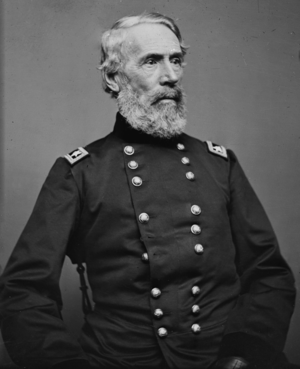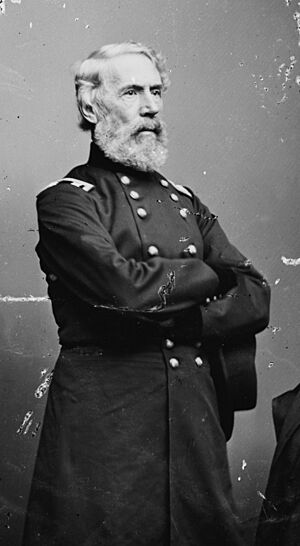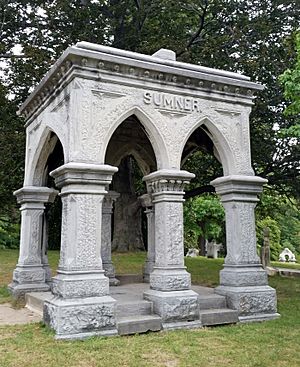Edwin Vose Sumner facts for kids
Quick facts for kids
Edwin Vose Sumner
|
|
|---|---|
 |
|
| Nickname(s) | Bull, Bull Head |
| Born | January 30, 1797 Boston, Massachusetts |
| Died | March 21, 1863 (aged 66) Syracuse, New York |
| Place of burial |
Oakwood Cemetery, Syracuse, New York
|
| Allegiance | United States of America Union |
| Service/ |
United States Army Union Army |
| Years of service | 1819–1863 |
| Rank | |
| Commands held | 1st U.S. Cavalry Department of the Pacific II Corps, Army of the Potomac |
| Battles/wars | Black Hawk War Mexican–American War Indian Wars Bleeding Kansas American Civil War |
| Spouse(s) | Hannah W. Foster |
| Children | 6, including Edwin Jr. and Samuel |
Edwin Vose Sumner (January 30, 1797 – March 21, 1863) was an officer in the United States Army. He became a Union Army general during the American Civil War. He was the oldest field commander of any Army Corps on either side during the war. People called him "Bull" or "Bull Head." This was because of his loud voice and a story that a musket ball once bounced off his head!
Sumner fought in several wars and conflicts. These included the Black Hawk War and the Mexican–American War. He also served on the Western frontier. During the first half of the Civil War, he led the II Corps of the Army of the Potomac. He was involved in the Peninsula Campaign, the Seven Days Battles, the Maryland Campaign, and the Battle of Fredericksburg. He passed away in March 1863 while waiting for a new assignment.
Contents
Early Life and Army Career
Edwin Vose Sumner was born in Boston, Massachusetts. His parents were Elisha and Nancy Vose Sumner. He went to school at Milton Academy.
In 1819, he joined the United States Army. He started as a second lieutenant. He was promoted to first lieutenant in 1825. Sumner's military career was helped by Samuel Appleton Storrow, a friend of his family. Sumner later named one of his sons after him.
On March 31, 1822, he married Hannah Wickersham Foster. They had six children. His son, Samuel Storrow Sumner, later became a general. His daughter, Mary Heron, married General Armistead L. Long.
Sumner fought in the Black Hawk War and other campaigns against Native American groups. In 1833, he became a captain. He was put in charge of a new cavalry unit called the U.S. Dragoon Regiment.
In 1838, he led a cavalry training center in Carlisle Barracks, Pennsylvania. He commanded Fort Atkinson in Iowa Territory from 1842 to 1845. He was promoted to major in 1846.
Fighting in the Mexican-American War
During the Mexican–American War, Sumner showed great bravery. He was recognized for his actions at the Battle of Cerro Gordo. This is where he got the nickname "Bull Head." People said a musket ball hit his head and bounced off! He was also recognized for his bravery at the Battle of Molino del Rey.
After the war, he became a lieutenant colonel in 1848. He served as the military governor of the New Mexico Territory from 1851 to 1853. In 1855, he was promoted to colonel.
In 1856, Sumner commanded Fort Leavenworth, Kansas. He was involved in the conflict known as Bleeding Kansas. In 1857, he led a mission against the Cheyenne people. In 1858, he commanded the Department of the West.
In 1861, Sumner advised President-elect Abraham Lincoln to carry a weapon. He also escorted Lincoln from Springfield, Illinois, to Washington, D.C..
Civil War Service
In February 1861, Sumner was chosen to be one of only three brigadier generals in the regular army. This made him the first new Union general during the start of the Civil War. He was sent to command the Department of the Pacific in California. Because of this, he did not take part in the early battles of the war in 1861. When Sumner went to California, his son-in-law, Armistead Lindsay Long, joined the Confederate Army.

In November 1861, Sumner returned to the East. He was given command of a division. When George B. McClellan organized the Army of the Potomac, Sumner was given command of one of its new corps. President Lincoln chose him as one of the four corps commanders because of his experience. The II Corps, which Sumner led, became known as one of the best units in the war. Sumner was the oldest general in the Army of the Potomac. He led his corps through the Peninsula Campaign and the Seven Days Battles.
At the Battle of Seven Pines, Sumner showed great leadership. He sent troops across the dangerous Chickahominy River. This action helped prevent a major Union defeat. He was recognized for his bravery at Seven Pines. At the Battle of Glendale, he was hit in the arm and hand by bullets, but they were spent (had lost most of their force). Even though he was strict, his troops generally liked him. He was promoted to major general in July 1862.
Antietam and Fredericksburg
In the fall of 1862, at the Battle of Antietam, Sumner was involved in a difficult situation. He ordered a division to attack into an area called the West Woods. This attack was met by a strong Confederate counterattack. The Union soldiers suffered many casualties and had to retreat. Some historians have criticized Sumner for this "reckless" attack. However, more recent studies suggest he made his decision based on the information he had at the time.
Sumner's other divisions pushed back the Confederate center. But he was deeply affected by the heavy losses his troops faced. Later, Ambrose Burnside took command of the Army of the Potomac. He put Sumner in charge of the Right Grand Division. In this role, Sumner took part in the terrible Battle of Fredericksburg. His II Corps suffered many casualties attacking strong Confederate positions at Marye's Heights.
Transfer and Death
After the Battle of Fredericksburg, Sumner asked to be relieved of his command. He was tired and disappointed by the disagreements within the army. He was reassigned to a new command in the Department of the Ohio. Before starting his new role, Sumner went to his daughter's home in Syracuse, New York, to rest. He became ill with a fever and passed away on March 21, 1863. He was buried in Syracuse's Oakwood Cemetery.
His two sons, Edwin Vose Sumner, Jr. and Samuel S. Sumner, both served in the Civil War. They also fought in the Spanish–American War.
Grave Site
Sumner is buried in Oakwood Cemetery in Syracuse. His grave site is part of the Teall family plot. There have been efforts by local groups to repair and maintain his grave.



